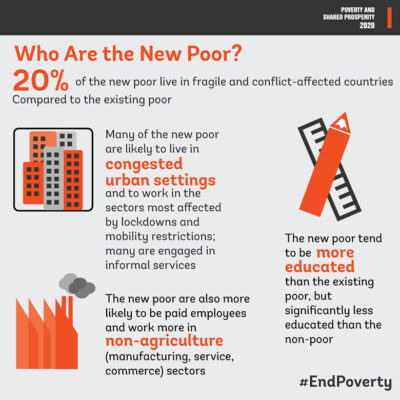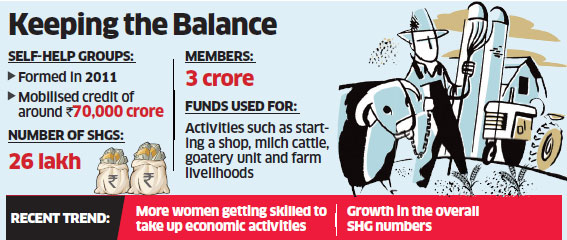- Home
- Prelims
- Mains
- Current Affairs
- Study Materials
- Test Series
Welfare of the urban poor cannot be an afterthought in economic growth plans
Urban poverty in India is over 25 percent. By 2030, that percentage would be at 50. Half of India is expected to urbanise by 2030 and at least half of that population could be such migrants. To make rapid economic progress, India needs to improve the well-being of the workforce that migrates to cities in the hope of a better life. A large number of migrants who returned to their homes in villages have come back to cities in search of work after the Covid pandemic. Social protection-related registration of informal workers has increased but the nature of opportunities continues to be insecure. With mechanisation resulting in the greater displacement of people dependent on farms, the trail of migrants in search of livelihoods is going to increase.

Steps to Improve the Lives of The Urban Poor
-
Need for elected leadership in urban local bodies
-
Article 243S (5) of the Constitution states: “Nothing in this article shall be deemed to prevent the Legislature of a State from making any provision for the Constitution of Committees in addition to the Ward Committees.”
-
The population of an urban ward varies from 1,500-6,000 in smaller towns to 30,000 to 2,00,000 in the metros.
-
Such a large population is not amenable to community-level connections.
-
As a result, local strongmen often determine access to public services for the poor.
-
-
Having elected representation at the basti or slum cluster level will empower a large number of people and improve the overall quality of life for these slums.
-
-
Access to public services for the right people
-
With the portability of names and cards, nearly half the urban population has access to cheap food grains under the National Food Security Act (NFSA).
-
But there is a need to establish identity markers based on the NFSA list and record the deprived households without access who may have been left out of this list.
-
Through a participatory identification of the poor by a community connect process, it should be possible to delete the non-entitled beneficiaries of NFSA as well.
-
-
Community-based awareness of social welfare schemes
-
A major reason for the lack of access to social welfare schemes is the lack of awareness at the grassroots level.
-
Once the deprived households are identified, special community connect campaigns to ensure access to social welfare schemes should be started.
-
Such campaigns should cover schemes related to LPG connection, bank accounts, life and accident insurance, EPFO and ESI facilities, and healthcare programmes like Ayushman Bharat and Pradhan Mantri Jan Arogya Yojana (PMJAY), employment schemes and drinking water, electricity, sanitation and other projects.
-
-
Utilize the reach of SHGs to implement social welfare schemes
-
Complete coverage of deprived households by SHGs should be attempted in a mission mode.
-
Nearly 70 lakh women in seven lakh self-help groups are under the National Urban Livelihood Mission.
-
-
This process should be accompanied by access to credit for all groups for diversification of livelihoods.
-
Creating basti-level women’s collectives will address several difficult challenges, loans for street vendors under Svanidhi Scheme, etc. is a good step in that direction.
-

-
Establish Migration Support Centres]
-
There is a need to establish Migration Support Centres.
-
These centres will make the arrival process of migrants to cities in search of work less traumatic by ensuring access to basic amenities.
-
The expansion of rental housing and property titles to settlers who fulfil the basic requirements will ease access to credit.
-
Support for the destitute and the homeless must be made a priority.
-
-
Skill Development
-
Skilling, upskilling, and re-skilling opportunities must be readily available for poor households.
-
Steps need to be taken to enable them to combine work with skill up-gradation.
-
Providing apprenticeships to those who are eligible will also help.
-

-
Urban local bodies must focus on the poor
-
Specially designated teams for the poor must be present in every municipality and cooperation.
-
A lack of funds prevents these bodies from employing enough resources and manpower to handle the volume of poor living in their jurisdiction.
-
-
All this requires governance reforms such as redirection of taxes collected, reallocation of stamp duties, etc.
-
Professionals with specialised skill sets should be brought in to effectively plan and handle their finances.
-
-
Rebuild census towns as robust growth centres
-
Census towns are rural gram panchayat but urban in character.
-
Many such rural growth clusters have been identified by the Ministry of Rural Development as part of the Rurban Mission.
-
Some are tourism clusters, some specific economic activity clusters, and yet others are farm and non-farm clusters.
-
These need to be reworked as robust growth centres.
-
-
Access to better education and health care]
-
The Atmanirbhar Health Infrastructure Yojana has prioritised strengthening urban health centres and the creation of frontline health teams.
-
Improvement of schools, health facility expansion, and anganwadis will go a long way in connecting deprived households to human development requirements.
-
-
Enforce minimum wages
-
Labour contractors very often disburse lower than the minimum wages, though they do not show that on paper.
-
Domestic helps need support for wages as oversupply leads to distress employment.
-
With a section of the population ageing and life expectancy increasing, there should be employment opportunities for people with caregiving skills.
-
-
Break caste hierarchies in urban living
-
Contrary to B R Ambedkar’s hope that urbanisation will break caste hierarchies, our large cities are among the most segregated.
-
This leads to uneven and unequal development across sections of society.
-
Master Plans must factor in the housing and welfare needs of the working class.
-
The loss of jobs and incomes after the pandemic has driven a large section of the urban poor to move back to their villages and withdraw their children from private schools. Healthcare costs have gone up and the cost of essential commodities, other than free food grains, has also increased. Without urgent intervention and robust policy changes, even rapid urbanization will not be able to drag a large majority of our population out of poverty. The well-being of the urban poor cannot be an afterthought.









 Latest News
Latest News
 General Studies
General Studies